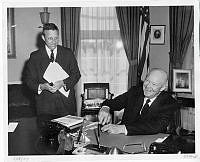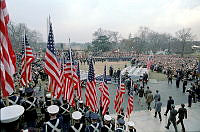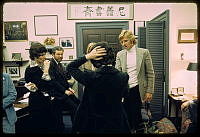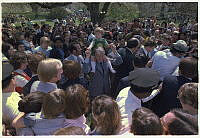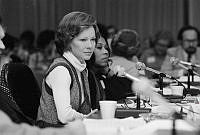Rubenstein Center Scholarship
John F. Kennedy at Gettysburg and Antietam Battlefields
In December 1960, as the country anticipated the centennial commemoration of the American Civil War, President Dwight D. Eisenhower asked the country to observe the upcoming anniversaries, “all to the end of enriching our knowledge and appreciation of this momentous chapter in our Nation’s history and of making this memorable period truly a Centennial for all Americans.”1 Many American families and citizens took this opportunity to visit the nation’s many Civil War battlefield sites.
President John F. Kennedy was profoundly moved by the heroism and dedication of those who served during the Civil War. He evoked the sacrifice in lives at the Battle of Antietam during his Veterans Day remarks at Arlington National Cemetery in 1961.2 Likewise, during an April 28, 1962, ceremony for descendants of Civil War Medal of Honor recipients on the South Lawn of the White House, the president remarked, “all of us are staggered by the courage …shown in so many struggles during the Civil War.”3
In the spring of 1963, President John F. Kennedy spent two Sundays away from the White House, touring the battlefields of Gettysburg, Pennsylvania, and Sharpsburg, Maryland.
On March 31, President Kennedy toured the Gettysburg battlefield with First Lady Jacqueline Kennedy, their daughter Caroline, and Paul B. Fay, Under Secretary of the Navy, along with his wife Anita and their three children. From Camp David, Kennedy’s motorcade drove the entourage to the battlefield some 25 miles away. Before arriving at the site, they picked up their guide for the day, Gettysburg High School history teacher and seasonal ranger Jacob M. Sheads at a nearby bowling alley. A Secret Service friend of Sheads had arranged for him to show the park to the Kennedy party.4

President John F. Kennedy took special interest in Massachusetts monuments during his Civil War battlefield visits, notably the monument to the 20th Massachusetts Infantry at Gettysburg, located near the site of the repulse of Pickett’s Charge.
Internet Archive Book ImagesWhile touring the battlefield, they saw many of the famous battlefield locations including “The Angle” at Cemetery Ridge, The Peach Orchard, and Little Round Top. Sheads pointed out markers and monuments that were of particular interest to the Massachusetts-born president, including a monument to the 20th Massachusetts Infantry. Sheads noted the Kennedys were interested most in what he called “the human side” of the battle.5
They might have stopped to see the Eisenhowers at their home near the battlefield, but the former president and his family were in California at the time.6 After viewing the sites of the battlefield for nearly two hours, the Kennedy entourage returned to Camp David via helicopter.
One week later on Sunday, April 7, the president toured Antietam battlefield, flying there by helicopter from nearby Camp David. Accompanying Kennedy was his brother, Senator Edward M. Kennedy and his wife Joan, Assistant Secretary of the Treasury James A. Reed, Special Assistant to the Secretary of the Army Ralph Horton, and advertising executive Lemoyne Billings. One newspaper described the president “looking like a casual tourist in sports attire and dark glasses.”7 Although the president provided no advance notice of his visit, Acting Park Superintendent Robert L. Lagemann was on hand to show the president the sites around the battlefield. During the tour, the president greeted several visitors who were also touring the park that day. One young woman said of meeting the president, “I just said, ‘I am glad to meet you’—what else could I say?”8
One site they did not view, however, was the monument dedicated in 1903 to former President William McKinley. As commissary sergeant of the 23rd Ohio Infantry during the battle, McKinley delivered coffee and food to his comrades while under fire. After touring the battlefield for about an hour and a half, Kennedy and company returned to Camp David by helicopter.9

The monument to William McKinley near Burnside’s Bridge that was overlooked during John F. Kennedy’s visit to the Antietam battlefield.
Library of CongressLagemann remarked after the tour that the president “knew quite a bit” about the battle, and showed notable attention to the part played by the Union Army’s Irish Brigade near the Sunken Road and monuments to Massachusetts troops.10
Several months later in Wexford, Ireland, Kennedy remarked upon his visit to the Gettysburg battlefield and noted the Irish-American sacrifice during the war, saying, “About 2 months ago I visited the Battle of Gettysburg, the bloodiest battlefield in the American Civil War, and one of the monuments to the dead was to the Irish Brigade.”11 The next day he evoked the Irish Brigade again during an address before the Irish Parliament in Dublin.12
For a president deeply interested in American history, these visits provided both a retreat from Washington and an educational experience. These Civil War battlefields not far from Washington, D.C., continue to provide Americans the same opportunity for exploration and learning as they did for President Kennedy, his family, and friends in the spring of 1963.








